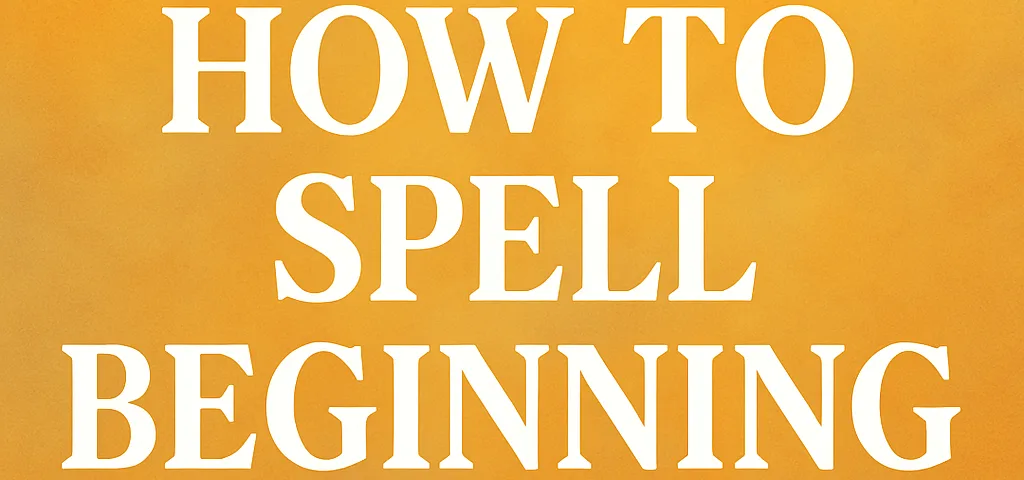
Dave Register – Everything you need to know in 2025
July 25, 2025
Valve Index 2 – What you should know in 2025
July 27, 2025How to Spell Beginning: The Ultimate Guide to Mastering This Tricky Word
Updated: July 2025
Ever found yourself staring at the word “beginning” and wondering if you’ve got it right? You’re definitely not alone! Learning how to spell beginning correctly is one of those spelling challenges that trips up even the most confident writers. With its double letters and tricky letter combinations, this nine-letter word has been causing spelling headaches for decades.
How to spell beginning might seem straightforward at first glance, but those double ‘n’s and the ‘i’ before ‘ng’ can throw anyone off their game. The correct spelling is B-E-G-I-N-N-I-N-G, and while that might look simple enough, there’s actually a lot more to mastering this word than just memorizing the letters.
The word “beginning” comes from the verb “begin,” and when we add the “-ing” suffix, we follow specific spelling rules that double the final consonant. This is why how to spell beginning becomes such a common question – it’s not just about memorization, it’s about understanding the spelling patterns that make English both fascinating and frustrating.
Whether you’re a student working on your spelling homework, a professional writer who wants to avoid embarrassing typos, or just someone who’s tired of second-guessing themselves every time they write this word, this guide will give you everything you need to master how to spell beginning once and for all!
Who Struggles with How to Spell Beginning? – You’re in Good Company
Students from elementary school through college find themselves stumbling over how to spell beginning. It’s one of those spelling words that appears on spelling tests year after year because it combines several challenging spelling concepts in one neat package.
Even professional writers sometimes double-check how to spell beginning. It’s not that they don’t know the correct spelling – it’s that this particular word combination can create a moment of uncertainty, especially when writing quickly.
For people learning English as a second language, figuring out how to spell beginning presents unique challenges. The double ‘n’ pattern doesn’t exist in many languages, and the relationship between “begin” and “beginning” isn’t always intuitive.
What Makes How to Spell Beginning So Challenging? – Breaking Down the Complexity
The Double Consonant Rule – Why We Get Two N’s
Understanding how to spell beginning requires grasping one of English spelling’s most important rules: consonant doubling. When we add “-ing” to the verb “begin,” we double the final ‘n’ because “begin” ends with a single consonant preceded by a single vowel in a stressed syllable.
This rule explains why how to spell beginning isn’t just “begining” with one ‘n’. The doubling pattern preserves the pronunciation and follows consistent English spelling conventions. It’s the same rule that gives us “running” from “run” and “swimming” from “swim.”
Learning this rule doesn’t just help with how to spell beginning – it’s a master key that unlocks the spelling of hundreds of other English words. Once you understand why the ‘n’ doubles, the spelling becomes logical rather than arbitrary.
Silent Letters and Tricky Sounds – The ‘I’ Before ‘NG’
Another aspect of how to spell beginning that causes confusion is the ‘i’ that appears before the ‘ng’ sound. Many people can hear the word clearly but struggle to identify all the letters when writing it down.
The ‘i’ in “beginning” isn’t silent, but it can be subtle in pronunciation, leading some people to spell the word as “beginng” or “begining.” Understanding how to spell beginning means recognizing that the ‘i’ is essential for the correct spelling, even if it’s not always prominent in speech.
This is why how to spell beginning often appears on spelling tests – it tests students’ ability to identify all the letters in a word, not just the ones they hear most clearly.
Length and Letter Patterns – Nine Letters of Complexity
How to spell beginning involves managing a relatively long word with multiple repeated letters. The pattern B-E-G-I-N-N-I-N-G includes three ‘n’s and two ‘i’s, which can be confusing to keep straight, especially when writing quickly.
The length factor in how to spell beginning means there are more opportunities for errors. Each letter position represents a potential mistake, from swapping letters to forgetting one entirely.
Many people find that understanding how to spell beginning improves when they break the word into chunks: “be-gin-ning” or “begin-ning.” This chunking strategy makes the nine-letter word more manageable and reduces spelling errors.
Why Is Learning How to Spell Beginning Important? – Beyond Basic Spelling
Mastering how to spell beginning is crucial for academic success because this word appears frequently in essays, reports, and creative writing assignments. Students who spell it correctly demonstrate attention to detail and understanding of spelling patterns.
In professional settings, knowing how to spell beginning correctly impacts your credibility and attention to detail. Business communications frequently use phrases like “beginning of the quarter” or “beginning stages of the project,” and spelling errors can undermine your professional image.
Understanding how to spell beginning builds confidence in your overall writing abilities. When you’re certain about spelling challenging words, you can focus on expressing your ideas rather than worrying about basic mechanics.
Where Do People Commonly Misspell Beginning?
How to spell beginning errors appear most frequently in school assignments, from elementary spelling tests to college essays. Students often write “begining” with only one ‘n’ or “beggining” with double ‘g’s instead of double ‘n’s.
Even with spell-check technology, how to spell beginning errors persist in emails, text messages, and social media posts. Auto-correct sometimes suggests incorrect alternatives, and people may accept the wrong suggestion without realizing it.
Perhaps the most problematic place for how to spell beginning errors is in professional documents where accuracy is crucial. Business reports, proposals, and formal correspondence require impeccable spelling to maintain credibility.
Personal Confidence – Writing Without Hesitation
Understanding how to spell beginning builds confidence in your overall writing abilities. When you’re certain about spelling challenging words, you can focus on expressing your ideas rather than worrying about basic mechanics.
Many people avoid using certain words in their writing because they’re unsure about the spelling. Once you master how to spell beginning, you’ll use it more freely and effectively in your communication.
The confidence that comes from mastering how to spell beginning often extends to other challenging words, creating a positive cycle of spelling improvement and writing confidence.
How to Master How to Spell Beginning – Proven Strategies
The most effective way to master how to spell beginning is through memory techniques that make the spelling pattern unforgettable. One popular method is the phrase “Begin with gin, then add ning” – this helps remember that “begin” stays intact when we add the suffix.
Understanding the spelling rule behind how to spell beginning makes the spelling logical rather than arbitrary. The consonant doubling rule explains why we double the ‘n’ when adding “-ing” to “begin.”
Regular practice is essential for mastering how to spell beginning. Start by writing the word correctly several times each day, then practice using it in sentences like “The beginning of the movie was exciting” or “We’re beginning our vacation tomorrow.”
How Much Time Does It Take to Learn How to Spell Beginning? – Realistic Expectations
The time required to master how to spell beginning varies significantly from person to person. Some people might learn it perfectly after a few focused practice sessions, while others might need weeks of regular practice to make it automatic.
Most people find that with focused effort, they can reliably spell how to spell beginning correctly within 1-2 weeks of regular practice. However, making it completely automatic might take longer, depending on how frequently you write the word.
Rather than cramming how to spell beginning practice into long sessions, short daily practice periods are more effective. Five minutes of focused practice each day typically produces better results than one lengthy session per week.
FAQs About How to Spell Beginning
What is the correct spelling of beginning?
The correct spelling is B-E-G-I-N-N-I-N-G with two ‘n’s in the middle. Many people mistakenly spell it as “begining” with only one ‘n’, but the consonant doubling rule requires the double ‘n’ when adding “-ing” to “begin.”
Why does beginning have two n’s?
How to spell beginning with two n’s follows the consonant doubling rule. When adding a suffix that starts with a vowel (like “-ing”) to a word ending in a single consonant preceded by a single vowel in a stressed syllable, you double the consonant.
What are common misspellings of beginning?
The most common mistakes when learning how to spell beginning include “begining” (missing one ‘n’), “beggining” (double ‘g’ instead of double ‘n’), and “beginig” (letters switched around).
How can I remember how to spell beginning?
A popular memory trick for how to spell beginning is the phrase “Begin with gin, then add ning.” You can also break it down as “begin” + “ning” with an extra ‘n’ for the doubling rule.
How long does it take to learn how to spell beginning?
Most people can master how to spell beginning within 1-2 weeks of regular practice. The key is consistent daily practice rather than cramming – just 5 minutes a day is more effective than longer, infrequent sessions.
Is beginning a difficult word to spell?
How to spell beginning is considered challenging because it combines multiple spelling concepts: consonant doubling, multiple repeated letters (three n’s and two i’s), and a subtle ‘i’ sound before ‘ng’ that some people miss when writing.
What spelling rule applies to beginning?
How to spell beginning follows the consonant doubling rule. Since “begin” ends with ‘n’ (single consonant) preceded by ‘i’ (single vowel) in a stressed syllable (be-GIN), we double the ‘n’ when adding “-ing.”
Should I use spell-check for beginning?
While spell-check can help catch how to spell beginning errors, it’s better to learn the correct spelling yourself. Some spell-checkers might not catch similar-looking misspellings, and you won’t always have spell-check available in every writing situation.
Conclusion: Your Journey to Spelling Success Starts Here
Mastering how to spell beginning correctly isn’t just about memorizing nine letters in the right order—it’s about building confidence in your writing and understanding the logical patterns that govern English spelling. By now, you’ve learned that the double ‘n’ in “beginning” isn’t arbitrary but follows the consonant doubling rule, making this seemingly tricky word entirely predictable once you understand the underlying grammar.
The key to spelling success lies in recognizing that how to spell beginning challenges even experienced writers, so you’re in excellent company when you find yourself double-checking this word. What matters most is developing reliable strategies that work for your learning style, whether that’s the “Begin with gin, then add ning” memory trick, breaking the word into manageable chunks, or understanding the grammatical rules that govern suffix addition.
Remember that
Consistent practice beats perfect practice every time. Five minutes of daily spelling practice will serve you far better than cramming sessions or hoping spell-check will always catch your errors. As you incorporate “beginning” into your regular writing vocabulary, you’ll find that the correct spelling becomes automatic, freeing up your mental energy to focus on expressing your ideas clearly and effectively.
The confidence you gain from mastering how to spell beginning extends far beyond this single word. You’re developing pattern recognition skills that will help you tackle other challenging spellings, from “occurrence” to “accommodate.” Each spelling victory builds upon the last, creating a foundation of writing confidence that serves you in academic, professional, and personal communication.
Moving forward, don’t be afraid to use “beginning” in your writing. Whether you’re crafting an essay introduction, drafting a business proposal, or writing a personal email, you now have the tools and knowledge to spell this word correctly every time. The beginning of your spelling mastery journey starts with conquering challenging words like this one.
Your improved spelling skills will enhance your credibility as a writer and communicator. Every correctly spelled word demonstrates your attention to detail and commitment to clear communication. So embrace your newfound spelling confidence after all, this is just the beginning of your journey toward becoming a more skilled and confident writer.




